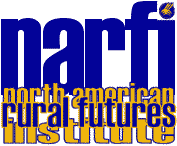Futures Thinker Bio: Don Marble
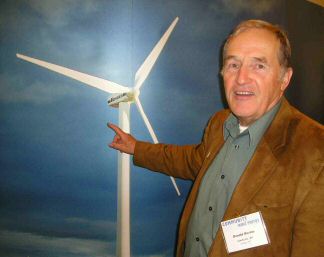
Don Marble grew up in Kalamazoo Michigan, graduated in 1961 with a degree in engineering and went on to get a Master's degree in aeronautical engineering, both at U of Michigan. During the summers, Don was a smoke jumper out of Missoula.
Following a stint with NASA in the Bay Area of California, Don returned to Missoula to go to law school. In 1967 he moved up to the Hi-Line of northern Montana and in 1972 was the first legal services attorney in Havre, which covered Liberty, Hill and Blaine counties. A job opened up in Chester (60 miles west of Havre along the Hi-Line) and he's been there ever since.
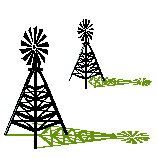
"It's just a great place to be! We raised our two boys up here. I just can't imagine living somewhere else."
Don retired from law in 2003, after practicing law for nearly 40 years. He was elected Liberty County Commissioner in 2002 and has served two of his 6 years in this job, which he obviously loves. Being an aeronautical engineer, Don's always been interested in the power and beauty of wind. "There's something about it. I've just always liked seeing an old Jacobs 32 volt charger and the blades turning. It's beautiful!"
Don Marble's Conference Report

Windustry, the sponsoring organization, is a nonprofit working to create an understanding of wind energy opportunities. The emphasis of the conference was clearly development of locally based wind projects.
The conference was held in the very impressive Minneapolis Convention Center in downtown Minneapolis. I was fortunate to take the Amtrak to and from the convention.
Opening Sessions - The Potential of Community Wind Projects
The opening plenary session on Wednesday was "Public Policy That Works for Community Wind." It was made clear that locally based wind developments happen when local and state public policy mandates appropriately. This is not to say that local development can do the job alone-rather some local component is needed. For example, in Montana, it seems to me, that if the default component of NWE is one or just a few major wind farms sponsored by out of state or even foreign money, it will have limited benefit for Montanans outside the immediate area of the development.
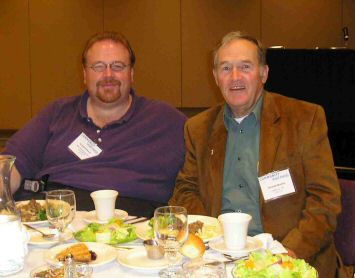
|
| Craig Erickson and Don Marble represented the Hi-Line of Montana at the Community Wind Energy Conference thanks to NARFI mini-grants that helped offset the cost of attending this important event. Craig and Don are among those leading the charge to see that Montana takes adavantage of its extraordinary perpetual resource, the winds that cross the Big Sky. |
I would prefer to see the Legislature or PSC require that part of the default portfolio would include numerous community based wind power projects scattered all over Montana that would benefit many communities. These wind farms could provide needed tax base for struggling county governments and local schools and this tax base needs to be spread around.
It seems to me that proponents of community wind development need to be working on a plan to present to the legislature. The grid interconnect law needs to be strengthen so that if excess energy is put into the grid, the producer would be paid a fair price for this energy. The DEQ grant and loan program needs to be fully funded.
Sessions followed on financing of projects, partnering with large projects with ample time for questions and discussion. Innovative community wind models were presented. Major turbine manufacturers were featured along with their many exhibits. The size of the new machines in truly amazing...3 MW and growing.
Second Day Sessions - The Process
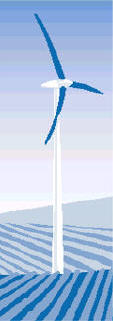
Thursday's sessions presented information on "wind development process." USDA representatives presented information on their programs, Sec. 9006 of the Farm Bill and others. Financing a project was discussed. Business structures were discussed in detail along with tax consequences of each. Tribal success stories were presented and some were impressive. The role of local government in wind development was examined. School projects are getting common, especially where they have significant wind resources. Farmer cooperatives are popular in Minnesota and Iowa.
Marketing produced power through PPA were discussed in detail as they are the key to any project-being able to sell your product as an acceptable price is critical. Transmission is also a key issue and it was discussed. It seems clear to me that the ability to sell "green tags" at rewarding prices may be the issue that will allow local, smaller wind developments to go "toe to toe" with the large wind farms and their larger resources. Unfortunately, in Montana, our green tag program seems to be stalled with NWE in bankruptcy. They don't seem to be pushing the program and consequently, there is not adequate funds to buy green tags that are for sale by Montana small wind turbines. The PSC and/or Legislature should put some pressure on NWE to energize this program since it may be the key to small community wind.
The lobby was filled with the booths of turbine manufacturers, engineers, NRG, state of Minnesota, consultants, etc. I spent a substantial amount of time talking to them as I find that is a good way to come to conclusions about issues being considered now by Liberty County.
Montana's Wind Future? Look to Minnesota and Iowa
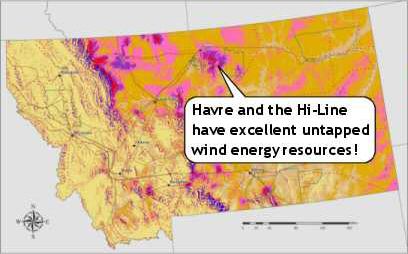
Minnesota and Iowa have a great many wind farms and developments – Montana with its great wind energy resource has very little development. The reason seems to be a lack of policy and programs encouraging development. For example, Minnesota pays 1.8 cents per kwh generated. The program may be ending since it has been such a success. The federal tax credit has expired and this has slowed development of new wind farms. Avoided cost payments are inadequate and the Legislatures need to make such payments more appropriate, especially for community based projects. Transmission capacity is limited. All these matters make development difficult in Montana.
More creative involvement of the electric coops needs to be worked on since the coops are the supplier of most of rural Montana. We need to develop more fully the concept of "distributed energy." Some think that coupling wind with gas turbines is worth considering. In north central Montana, there are wind areas where there may be shut-in gas wells that may never see development because gas pipelines are too distant. The gas would power turbines for the times when the wind is not blowing. Maybe this could also be done with some hydro projects were the water resource is inadequate for continued cycle gas generation.
Finally it was nice to see Heather of NWSeed receive recognition as one of the leaders in renewable energy development. She is well informed and people recognize this. NWSeed made our county shop turbine possible.
--Don Marble--
NARFI Futures Thinker
